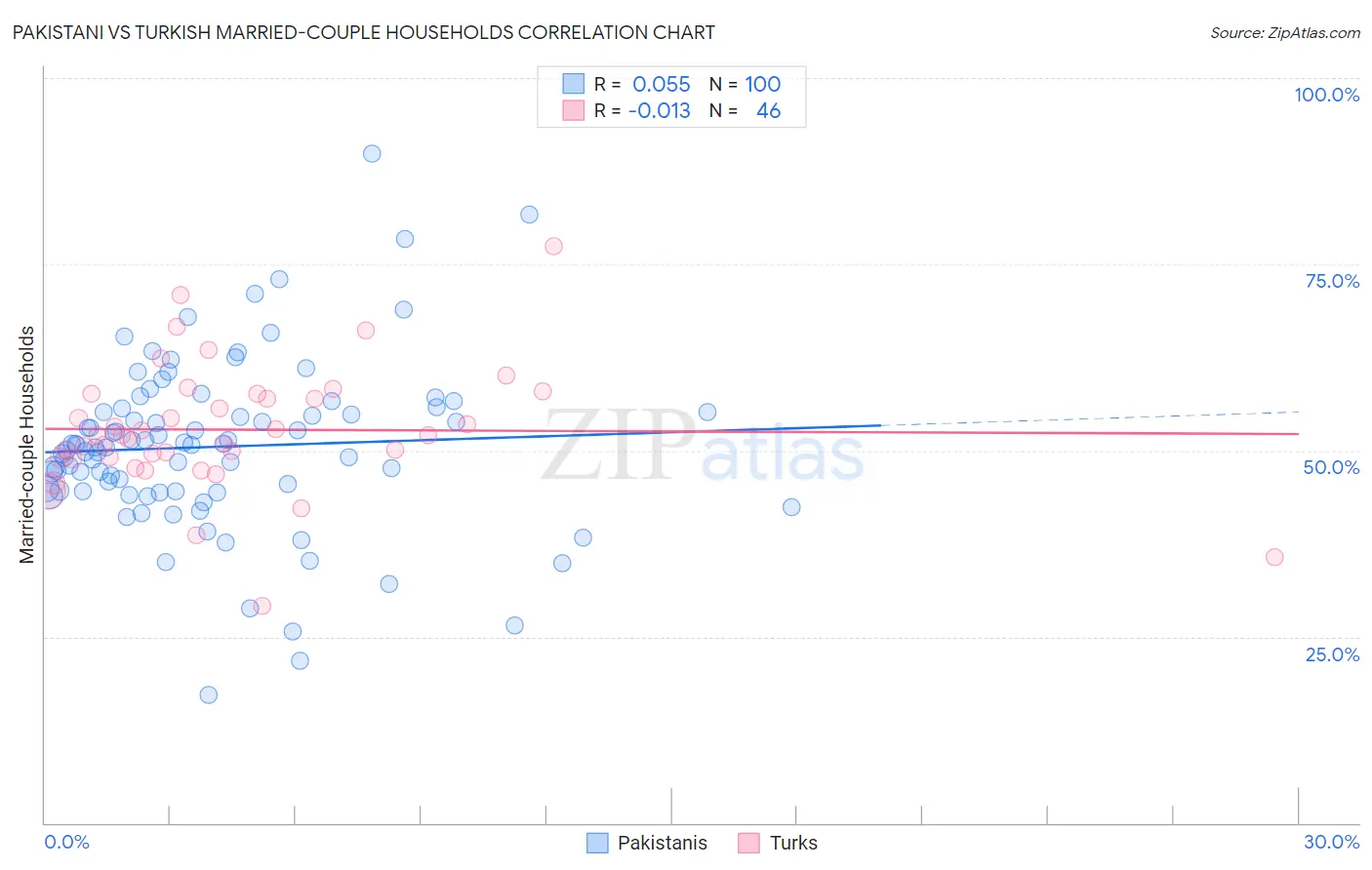Pakistani vs Turkish Married-couple Households
COMPARE
Pakistani
Turkish
Married-couple Households
Married-couple Households Comparison
Pakistanis
Turks
47.3%
MARRIED-COUPLE HOUSEHOLDS
88.6/ 100
METRIC RATING
126th/ 347
METRIC RANK
47.8%
MARRIED-COUPLE HOUSEHOLDS
96.1/ 100
METRIC RATING
101st/ 347
METRIC RANK
Pakistani vs Turkish Married-couple Households Correlation Chart
The statistical analysis conducted on geographies consisting of 335,163,838 people shows a slight positive correlation between the proportion of Pakistanis and percentage of married-couple family households in the United States with a correlation coefficient (R) of 0.055 and weighted average of 47.3%. Similarly, the statistical analysis conducted on geographies consisting of 271,700,088 people shows no correlation between the proportion of Turks and percentage of married-couple family households in the United States with a correlation coefficient (R) of -0.013 and weighted average of 47.8%, a difference of 1.1%.

Married-couple Households Correlation Summary
| Measurement | Pakistani | Turkish |
| Minimum | 17.3% | 29.1% |
| Maximum | 89.9% | 77.4% |
| Range | 72.7% | 48.3% |
| Mean | 50.5% | 52.8% |
| Median | 50.6% | 52.0% |
| Interquartile 25% (IQ1) | 44.5% | 49.0% |
| Interquartile 75% (IQ3) | 55.5% | 57.6% |
| Interquartile Range (IQR) | 10.9% | 8.5% |
| Standard Deviation (Sample) | 11.5% | 8.5% |
| Standard Deviation (Population) | 11.4% | 8.4% |
Similar Demographics by Married-couple Households
Demographics Similar to Pakistanis by Married-couple Households
In terms of married-couple households, the demographic groups most similar to Pakistanis are Australian (47.4%, a difference of 0.030%), Celtic (47.3%, a difference of 0.040%), Zimbabwean (47.4%, a difference of 0.050%), Immigrants from Venezuela (47.4%, a difference of 0.060%), and Immigrants from Peru (47.3%, a difference of 0.070%).
| Demographics | Rating | Rank | Married-couple Households |
| Chileans | 92.2 /100 | #119 | Exceptional 47.5% |
| Puget Sound Salish | 90.5 /100 | #120 | Exceptional 47.4% |
| Immigrants | Eastern Europe | 90.3 /100 | #121 | Exceptional 47.4% |
| Okinawans | 90.1 /100 | #122 | Exceptional 47.4% |
| Immigrants | Venezuela | 89.3 /100 | #123 | Excellent 47.4% |
| Zimbabweans | 89.2 /100 | #124 | Excellent 47.4% |
| Australians | 89.0 /100 | #125 | Excellent 47.4% |
| Pakistanis | 88.6 /100 | #126 | Excellent 47.3% |
| Celtics | 88.1 /100 | #127 | Excellent 47.3% |
| Immigrants | Peru | 87.9 /100 | #128 | Excellent 47.3% |
| Immigrants | Iraq | 87.8 /100 | #129 | Excellent 47.3% |
| Immigrants | Hungary | 87.8 /100 | #130 | Excellent 47.3% |
| Immigrants | Denmark | 87.5 /100 | #131 | Excellent 47.3% |
| Immigrants | Ukraine | 86.7 /100 | #132 | Excellent 47.3% |
| South Africans | 86.4 /100 | #133 | Excellent 47.3% |
Demographics Similar to Turks by Married-couple Households
In terms of married-couple households, the demographic groups most similar to Turks are Slavic (47.8%, a difference of 0.020%), Hawaiian (47.8%, a difference of 0.020%), Immigrants from South Africa (47.8%, a difference of 0.030%), Immigrants from Italy (47.9%, a difference of 0.060%), and Immigrants from Austria (47.9%, a difference of 0.070%).
| Demographics | Rating | Rank | Married-couple Households |
| Americans | 96.9 /100 | #94 | Exceptional 47.9% |
| Immigrants | Belgium | 96.8 /100 | #95 | Exceptional 47.9% |
| Immigrants | Egypt | 96.6 /100 | #96 | Exceptional 47.9% |
| Latvians | 96.5 /100 | #97 | Exceptional 47.9% |
| Immigrants | North Macedonia | 96.4 /100 | #98 | Exceptional 47.9% |
| Immigrants | Austria | 96.4 /100 | #99 | Exceptional 47.9% |
| Immigrants | Italy | 96.3 /100 | #100 | Exceptional 47.9% |
| Turks | 96.1 /100 | #101 | Exceptional 47.8% |
| Slavs | 96.0 /100 | #102 | Exceptional 47.8% |
| Hawaiians | 96.0 /100 | #103 | Exceptional 47.8% |
| Immigrants | South Africa | 96.0 /100 | #104 | Exceptional 47.8% |
| Immigrants | Czechoslovakia | 95.5 /100 | #105 | Exceptional 47.8% |
| Portuguese | 95.5 /100 | #106 | Exceptional 47.8% |
| Estonians | 94.7 /100 | #107 | Exceptional 47.7% |
| Immigrants | Japan | 94.4 /100 | #108 | Exceptional 47.7% |